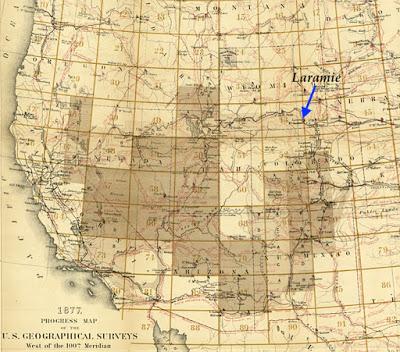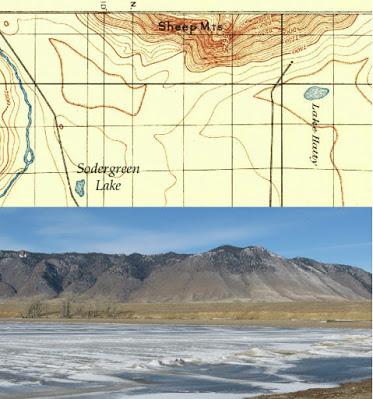
Two views of Sheep Mountain[s]: 1895 USGS map and 2011 photo looking northwest from Sodergreen Lake.
To refresh your memory, and for you who missed Mapping the Laramie Plains I: in pursuit of the 3rd dimension, this story began with the promise of a map of the Laramie area on which "almost every hill and cañon [sic] can be determined at a glance!" according to the Laramie Boomerang in 1893. Yet the post ended before we could share in the reporter's excitement. That's because the back story was so long—three millennia.
It began in the 12th century B.C., when Egyptian scribe Amennakhte drew the earliest surviving topographic map—a map which shows the shape of the land. It featured a winding line with large flat cones on either side—a valley bottom between hills. Maps would be similarly crude for the next three thousand years, with hills and mountains drawn as simple pictures, and approximately located at best.
But by the early 1800s, techniques were much improved. Maps by William Clark of the Lewis and Clark expedition, and Charles Preuss, John C. Frémont's cartographer, added significantly to our geological knowledge. But they weren't perfect. Clark put today's Colorado too far north, thereby eliminating the Laramie Plains. Preuss's map was accurate for major features, but finer details could be unreliable. And on both maps, mountains were shown using hachures—short parallel lines suggesting relief but with little specific information. The third dimension remained elusive.
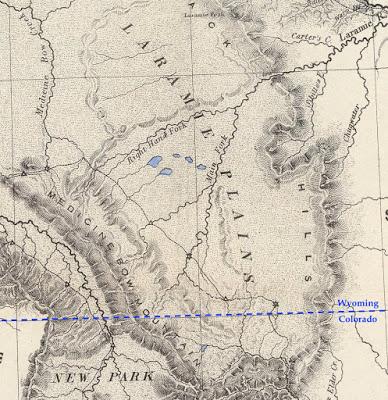
Excerpt from Preuss's map, showing the Laramie Plains crossed by the mysterious Right Hand Fork of the Laramie River (state line added). David Rumsey Map Collection.
After a grim hiatus, mapping resumes
Through the 1850s, the Army Corps of Topographical Engineers continued to explore and map the American West. The emphasis was route-finding, exemplified by the Pacific Railroad Survey—four concurrent expeditions looking for a way across the Rocky Mountains. But mapping came to a halt with the start of the Civil War, except as needed by the Union Army.
About five years after the War's end, the government began to invest again in maps. They were badly needed, for while France and England were putting final touches on national maps, and a dozen more countries had surveys in progress, the United States lagged far behind.
In 1870, a young US Army Lieutenant, George Montague Wheeler, presented a detailed proposal to map the United States west of 100º longitude (which roughly bisects the Dakotas). In need of post-war work, the Corps of Topographic Engineers jumped at the opportunity, and in 1871, Wheeler launched his "Survey West of the One-Hundredth Meridian."

George Montague Wheeler ca. 1872; National Portrait Gallery (SI)
Where on Earth are we?
Just a year later, on November 30, 1872, James H. Hayford of the Laramie Daily Sentinel reported, "Some parties are putting up some aparatus [sic] and a temporary observatory near our office today, under the supervision of Lieut. Wheeler [it's unlikely Wheeler himself was present], for the purpose of taking some astronomical observations to determine the latitude and longitude of this place."
Wheeler's men, John H. Clark and F.R. Simonton, had already made astronomical observations at two other locations in Wyoming Territory: Fort Fred Steele and Cheyenne, where they came up with a handy improvement to standard procedure. "A large wall-tent drawn over a framework formed the observatory. ... it was found to be an improvement to retain the ridge-pole [during observations] as a support against the violent winds so prevalent."
All in all though, working conditions were luxurious compared to those of the Frémont expedition 30 years earlier. Clark and Simonton could partake in the conveniences offered by the Laramie City, just four years old. Furthermore, their tent "was furnished with all the appliances of a field and temporary observatory, such as stools, stands, tables, and the like, and nothing was wanting as to equipment for first-class field-work. The [local] telegraph company furnished the line."
Longitude by wire
However, one thing hadn't changed since Frémont's time—longitude remained the greater challenge. There was no way to measure it directly. Instead, it was calculated based on the difference in time of specific celestial events in Laramie, and in Salt Lake City where longitude had been determined in 1869. [If you are thinking Laramie and SLC are in the same time zone, you're correct. But for this procedure, the surveyors used local time, also called solar time.]
To determine time difference, Clark and Simonton relied on the near-instantaneous communication of telegraphy. Time was recorded by chronograph—a combination of chronometer (clock) and paper-covered cylinder. Powered by a small battery, the cylinder turned exactly once per minute, as a pen marked a chronometer tick every second. After each minute, the pen-holder advanced slightly. The result was a piece of paper covered in parallel lines of tick-marks, a printed record of time.
As the chronometer clicked and the cylinder turned, the men added astronomical observations to the chronograph record, in real time. One man kept an eye on the heavens while also recording meteorological conditions and other notes on a paper form. When a star to be tracked approached, he notified the Observer at the telescope. At the moment the star entered the telescope's field of view, the Observer tapped a key wired to the chronograph, thereby leaving a mark on the paper. He did the same when the star passed out of view.

Drum chronograph by William Bond & Son, ca. 1850; "an instrument that touched a pen to a paper-wrapped cylinder to record both the beats of the clock and the instant of a celestial event, signaled when an observer pressed a telegraph key." (courtesy National Museum of American History)
This was only half the project. Each time the Observer in Laramie pressed the key, the signal also was sent via telegraph to a chronograph in Salt Lake City, overseen by their coworker, E.P. Austin. From the two sets of long paper records, they determined that stars passed over Laramie 25 minutes and 12 seconds before passing over Salt Lake City, putting the Laramie observatory at approximately 105º 35' 24" longitude (only about four blocks too far east according to Google Earth, not bad for field data!).
Star-gazing in Laramie, Wyoming in December
Obviously, Clark and Simonton were able to determine longitude much more accurately than Frémont had three decades before. But the work was challenging even so. They had constructed a rigid base for their instruments, but thundering trains shook them out of adjustment, and the metal contracted and expanded with temperature. Ink froze on the coldest nights, and the men's concentration waxed and waned with weather and amount of sleep.
So for accuracy, multiple stars were observed on multiple nights—but only when skies were clear at both ends of the telegraph line. To get enough observations, Clark and Simonton spent most of December in Laramie, "subjected to too much cold and too many wind and dust storms for any human brain and muscle to effect its best work in astronomy," according to Clark.
The future arrives
Wheeler's 1877 Progress Map; published sheets are brown. Laramie is near the east edge of Sheet 43. David Rumsey Map Collection.
In just eight years, Wheeler's crews surveyed 333,000 square miles; 75 topographic atlas sheets were produced (but no Laramie Sheet). The tradition of representing relief using hachures continued, often with the addition of spot elevations (numbers). But there was a revolution afoot. During the same time, John Wesley Powell and Almon Harris Thompson, of the US Geographical and Geological Survey of Territories, were producing topographic maps using contour lines, which connected points of equal elevation. These maps showed the shape of the land in greater detail and more accurately.
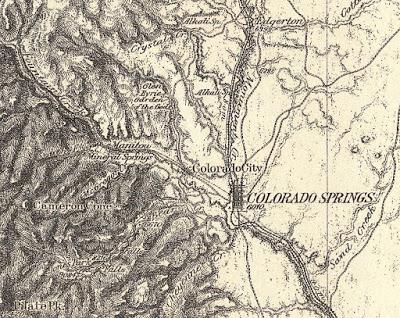
Excerpt from Wheeler's hachured "Central Colorado Atlas Sheet # 62a" (1878). Click to view scattered spot elevations. David Rumsey Map Collection.
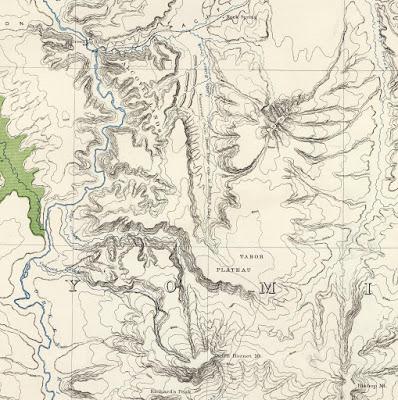
Excerpt from Powell and Thompson's contour map: "Green River from the Union Pacific Rail Road [WY] to White River [CO]" (1876); green marks irrigable land. David Rumsey Map Collection.
Mapping the Laramie Plains
In 1878, Wheeler's survey and three others were replaced with a single agency, the United States Geological Survey (USGS), tasked with "classification of the public lands, and examination of the geological structure, mineral resources, and products of the national domain." In 1882, its responsibilities were expanded to include preparation of a national map.
A decade later, on August 26, 1892, the Laramie Boomerang had great news. USGS surveyors Frank Tweedy and James McFarland had arrived and would "commence work upon the topography of this section of the country"—part of the national map of the United States already ten years underway. "This vast map will take at least 25 more years to complete [it would be more like a century] ... [and] when completed, would, if spread out, cover a little over 3/4 acre ..."
Obviously impractical, the great map had been divided into sheets, each named for a prominent local feature (for example, the Laramie Sheet). Vertical relief would be shown with contour lines, now recognized as far better than hachures, which cluttered maps, provided limited information, and were expensive to draw and print (almost as costly as fieldwork!).
No need to bother with longitude
The point established 20 years earlier, by Clark and Simonton of the Wheeler survey, did not go to waste. Tweedy and McFarland used it as the starting point for their survey. From it, they ran a baseline along the bed of the Union Pacific Railroad north of Laramie for 2.5 miles. The ties supported their tape nicely, and there was no brush to clear.
Their methods show how far accuracy had come. The tape was held at 20 lb. tension using a spring balance at one end. After every four lengths, they remeasured and calculated the average. The metal tape was precisely 300 ft long, but that was at 62º F. So they tried to work mainly on cloudy days or at night to minimize expansion and contraction. They also kept a record of air temperature, for later adjustment (0.02289456 inch per degree).
From the baseline, Tweedy and McFarland established points across the Laramie Plains through triangulation—measuring angles. No longitude determinations needed! And no trees obscured their view. They measured distance, direction and height of prominent features—mountain summits, ends of ridges, forks of creeks, and so forth. They also made detailed sketches of landscapes.
After several months, Tweedy boarded a train and transported the data and sketches to Washington DC, where he and others would turn them into a map.
Reading the lines
Six months later, in March of 1893, County Surveyor W.O. Owen received preliminary sheets for review (Owen had mapped Albany County the decade before, using shading to show relief). According to the excited Boomerang reporter who saw them, "The contour lines are so explicit that almost every cañon and hill can be determined at a glance."
Well, maybe. For many people, contour maps were new and counterintuitive. So the USGS provided an explanation with each map to help users interpret the winding lines. "Each contour [line] passes through points which have the same altitude. One who follows a contour on the ground will go neither uphill nor downhill, but on a level ... a succession of these contour lines far apart on the map indicates a gentle slope; if close together, a steep slope; and if the contours run together in one line, as if each were vertically under the one above it, they indicate a cliff."
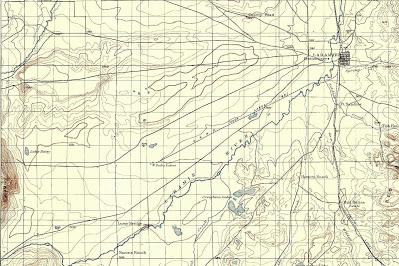
Excerpt from first Laramie Sheet (USGS 1895). Increasingly-close lines east of Laramie are foothills of the Laramie Range. Southeast of town, Red Buttes have dense lines on their steep sides, and none on the flat tops. Gentle terrain (lines far apart) stretches west for miles before meeting the dark steep face of Sheep Mountain.
Even the depressions of the Laramie Basin were mapped using contour lines. In fact, they are textbook examples—literally! They appeared as Plate 170B in "The Interpretation of Topographic Maps" (USGS 1908). "In many parts of the country are depressions or hollows with no outlets. The contours, of course, surround these, just as they surround hills. The small hollows known as sinks are usually indicated by hachures, or short dashes, on the inside of the curve."
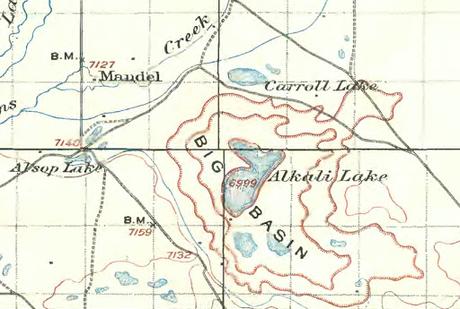
Excerpt from "Plate 170B: Special types of lakes: part of Laramie Sheet" showing hollows or sinks of the Laramie Plains (USGS 1908).
Sources
These are some of the more interesting sources I found:
David Rumsey Map Collection (kinda like the Hotel California—hard to leave)
USGS Historical Topographic Maps
Evans, R.T., and Frye, H.M. 2009. History of the topographic branch (division): U.S. Geological Survey Circular 1341, 196 p. (PDF; unfortunately illustrations are missing)
For more about longitude determination, see the great Wikipedia article: History of longitude, especially "Land surveying and telegraphy". True enthusiasts will want to read "Longitude by Wire: Finding North America" by Richard Stachurski (2009).
Cohen, Paul. 2002. Mapping the West; America's Westward Movement 1524-1890. Hardcover. 65 fascinating maps and their stories (plus a very interesting account by David Rumsey of how he got hooked on maps).
This post is an expanded version of the second of two articles about mapping the Laramie Plains, my most recent contribution to the "Laramie History" column in the Laramie Boomerang.
